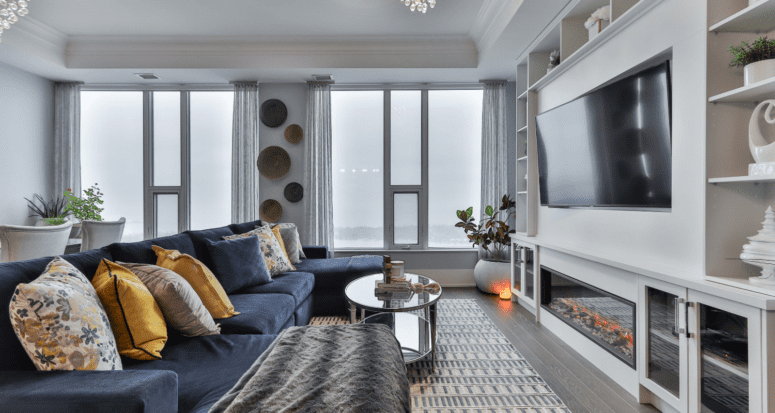How Important Is Staging for Some Homes Than Others? Here’s Why.
- Published on
- 4 min read
-
 Kristine Hansen Contributing AuthorClose
Kristine Hansen Contributing AuthorClose Kristine Hansen Contributing Author
Kristine Hansen Contributing AuthorKristine Hansen resides in a 1920s Milwaukee bungalow and contributes stories about the real-estate market to outlets that include Realtor.com and HomeLight.com and also covers art, design and architecture for ArchitecturalDigest.com, Invaluable.com and Milwaukee Magazine.
When Sedona, AZ, interior decorator Jessica Moreau of Moreau Design put her house on the market last year, she knew exactly how to showcase her home for a top-dollar sale. Instead of spending thousands of dollars to update her kitchen, Moreau focused on inspiring buyers with staging. She laid out fresh lemons, a wood cutting board, and a vase of fresh flowers.
“It conveys the message of ‘This is a culinary experience,’” she explains. “If you can’t change the kitchen, you can put in culinary accessories. Playing with people’s senses is really powerful.” The home sold for $25,000 above asking price; the buyer placed the offer after a preview showing before the listing went live.
Studies prove that staging helps homes sell faster and for more money. In the National Association of Realtors’ (NAR) 2019 Profile of Home Staging, 83% of buyer’s agents reported that it’s easier for clients to visualize themselves in a staged home. A quarter of surveyed agents said that staging a home resulted in an increased offer of between 1% and 5%.
Still, the degree that staging benefits a listing varies from sale to sale. Your current market conditions, property price, and selling timeline all influence how important staging is for your home. We’ll break down the seven factors that most influence staging’s impact. For added insight, we consulted Moreau and top real estate agent Cyndie Gawain, who sells properties 58% faster than local agents in Dallas.

1. Staging is more important in a buyer’s market
Staging is more critical in a buyer’s market where there are more buyers than homes available. When your home is competing for buyers’ attention against many other similar properties, staging can help trigger the emotional response that buyers want to feel before placing an offer.
Gawain confirms that staging can significantly improve a home’s chance of selling in this type of market. She shares an example of her recent client’s slow-selling $1.2 million home:
“The sellers pulled it off and staged it, and dropped the house’s asking price only slightly. There were multiple offers, whereas they were getting no showings before.”
2. Staging a vacant home helps sell a lifestyle
If your home is empty, staging can have a significant impact on your sale. On average, vacant homes sell for $10,000 less and sit on the market six days longer than furnished homes.
It’s easier for buyers to envision living in a home with furniture. Plus, furniture creates reference points for scale — with proportional furniture, rooms may appear larger furnished than they would unfurnished.
Staging can also highlight a home’s unique features and distract from blemishes. For instance, staging armchairs next to a fireplace creates a cozy vignette, while a well-placed rug helps mask old flooring.
3. Staging is critical if you need a fast sale
If you need to sell your house fast, don’t skimp on staging. In HomeLight’s recent Top Agent Insights report, 83% of agents say that a staged home sells faster than an unstaged home. Over 21% of agents (the largest grouping) said staged homes sell 6% to 10% faster. Depending on the average days on market for your area, staging could shave weeks to months off your home sale timeline.

4. Staging is less important for well-designed homes
A well-designed home may only require a deep clean, declutter, and depersonalization. For instance, Gawain recently worked with a Dallas seller who had an impeccably designed mid century modern ranch home.
“It showed really well because of the mid century modern style furniture [the seller] had chosen,” says Gawain. “Just her furniture drew in clients who were interested in mid century modern. It put the home over the edge.”
If you’re looking for honest, candid advice about whether or not your home is “well-designed,” heed the advice of your agent, who knows what styles appeal to buyers in your market.
5. Staging matters more at some price points than others
The value of staging ranges depending on how your home is priced compared to other homes in the market:
No need to stage an underpriced home
Skip the staging if your listing is “priced to move” (i.e., a listing price below market value). “For a lower-priced home that could sell in two days, I don’t think I’d put the money in staging,” shares Gawain, who notes that the discounted price is often enough motivation for buyers. Instead, she suggests painting the walls a neutral shade like Sherwin-Williams’ Repose Gray to freshen up the interior.
Staging is essential for homes priced above market value
If prices are rising in your neighborhood and you’re trying to fetch slightly above market value, staging is critical. You’ll need to do everything in your power to convince buyers that your home is worth more than the competition. Staging helps give your home move-in ready charm, something many buyers are willing to pay a premium for.
Staging a luxury home can inspire buyers to splurge
“At higher price points, it’s even more important [to stage],” says Gawain. Inman reports that higher-end homes spend an average of 506 days on the market — far more days than it takes the average single-family home to sell. Luxury homes take longer to sell since only a limited buyer pool can afford their high price tags. When you’re selling a luxury home, you’re selling a lifestyle more than anything else. Staging a home in the latest interior design style attracts buyers looking for a unique property to live and entertain in.
6. Staging is more important in some rooms than others
Thankfully, you don’t have to stage every inch of your home to make an impact. Our research reveals that the living room, primary bedroom, and kitchen are the most important rooms to stage.
“A lot of people will stage the primary suite. I’m not sure that’s really necessary unless, for some reason, it’s not clear how to use it or decorate it,” Gawain weighs in. For instance, in a bedroom with a sloped ceiling, you can stage an upholstered reading chair and side table where the ceiling is lowest to show off usable space.
From her experience, the entryway and the living room are the most important areas to stage. “You want to nab them when they first come in the house,” says Gawain. She recommends staging a stylish entry table with a vase of flowers, a round mirror, and staggered lanterns lit with flameless candles.

7. Staging works best when you declutter and depersonalize first
“If you have too much stuff, it looks horrible,” says Gawain. “You can’t see the house.”
You don’t need to go all Marie Kondo and get rid of nearly everything you own, but you should pare down your belongings for a more spacious effect. Our research indicates that decluttering can add over $2,500 to your home’s sale price. And don’t forget to depersonalize your home while you’re at it. Remove family photos, pet toys, and religious items to create a neutral space the buyer can imagine living in.
The importance of staging varies home to home
There is no one-size-fits-all approach to staging. Consult your real estate agent to determine how important staging is for your home sale. If they believe staging will help sell your home faster or for more money, they can connect you with a tried-and-true professional stager in their network.
Header Image Source: (Sidekix Media / Unsplash)
